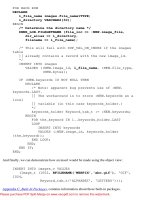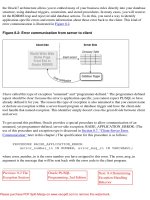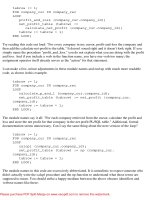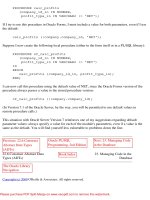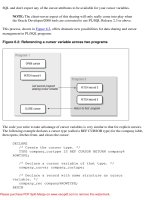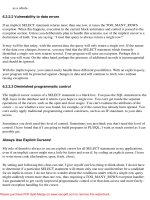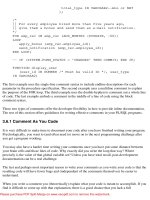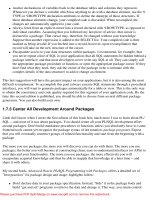Oracle PL/SQL Language Pocket Reference- P6
Bạn đang xem bản rút gọn của tài liệu. Xem và tải ngay bản đầy đủ của tài liệu tại đây (190.85 KB, 50 trang )
SQL and don't expect any of the cursor attributes to be available for your cursor variables.
NOTE: The client-server aspect of this sharing will only really come into play when
the Oracle Developer/2000 tools are converted to use PL/SQL Release 2.3 or above.
This process, shown in
Figure 6.2, offers dramatic new possibilities for data sharing and cursor
management in PL/SQL programs.
Figure 6.2: Referencing a cursor variable across two programs
The code you write to take advantage of cursor variables is very similar to that for explicit cursors.
The following example declares a cursor type (called a REF CURSOR type) for the company table,
then opens, fetches from, and closes the cursor:
DECLARE
/* Create the cursor type. */
TYPE company_curtype IS REF CURSOR RETURN company%
ROWTYPE;
/* Declare a cursor variable of that type. */
company_curvar company_curtype;
/* Declare a record with same structure as cursor
variable. */
company_rec company%ROWTYPE;
BEGIN
Please purchase PDF Split-Merge on www.verypdf.com to remove this watermark.
/* Open the cursor variable, associating with it a SQL
statement. */
OPEN company_curvar FOR SELECT * FROM company;
/* Fetch from the cursor variable. */
FETCH company_curvar INTO company_rec;
/* Close the cursor object associated with variable. */
CLOSE company_curvar;
END;
That looks an awful lot like explicit cursor operations, except for the following:
●
The REF CURSOR type declaration
●
The OPEN FOR syntax which specified the query at the time of the open
While the syntax is very similar, the fact that the cursor variable is a variable opens up many new
opportunities in your programs. These are explored in the remainder of this section.
6.12.1 Features of Cursor Variables
Cursor variables let you:
●
Associate a cursor variable with different queries at different times in your program execution.
In other words, a single cursor variable can be used to fetch from different result sets.
●
Pass a cursor variable as an argument to a procedure or function. You can, in essence, share
the results of a cursor by passing the reference to that result set.
●
Employ the full functionality of static PL/SQL cursors for cursor variables. You can OPEN,
CLOSE, and FETCH with cursor variables within your PL/SQL programs. You can reference
the standard cursor attributes -- %ISOPEN, %FOUND, %NOTFOUND, and %
ROWCOUNT -- for cursor variables.
●
Assign the contents of one cursor (and its result set) to another cursor variable. Because the
cursor variable is a variable, it can be used in assignment operations. There are, however,
restrictions on referencing this kind of variable, addressed later in this chapter.
6.12.2 Similarities to Static Cursors
One of the key design requirements for cursor variables was that as much as possible the semantics
used to manage cursor objects would be the same as that of static cursors. While the declaration of a
cursor variable and the syntax for opening it are enhanced, the following cursor operations are
unchanged for cursor variables:
●
The CLOSE statement. In the following example I declare a REF CURSOR type and a cursor
variable based on that type. Then I close the cursor variable using the same syntax as for that
of a static cursor:
Please purchase PDF Split-Merge on www.verypdf.com to remove this watermark.
DECLARE
TYPE var_cur_type IS REF CURSOR;
var_cur var_cur_type;
BEGIN
CLOSE var_cur;
END;
●
Cursor attributes. You can use any of the four cursor attributes with exactly the same syntax as
for that of a static cursor. The rules governing the use and values returned by those attributes
match that of explicit cursors. If I have declared a variable cursor as in the previous example, I
could use all the cursor attributes as follows:
var_cur%ISOOPEN
var_cur%FOUND
var_cur%NOTFOUND
var_cur%ROWCOUNT
●
Fetching from the cursor variable. You use the same FETCH syntax when fetching from a
cursor variable into local PL/SQL data structures. There are, however, additional rules applied
by PL/SQL to make sure that the data structures of the cursor variable's row (the set of values
returned by the cursor object) match that of the data structures to the right of the INTO
keyword. These rules are discussed in Section 6.12.6, "Rules for Cursor Variables".
Because the syntax for these aspects of cursor variables remain unchanged, I won't cover them again
in the remainder of this section. Instead I will focus on the new capabilities available and the changed
syntax required for cursor variables.
6.12.3 Declaring REF CURSOR Types and Cursor Variables
Just as with a PL/SQL table or a programmer-defined record, you must perform two distinct
declaration steps in order to create a cursor variable:
1. Create a referenced cursor TYPE.
2. Declare the actual cursor variable based on that type.
The syntax for creating a referenced cursor type is as follows:
TYPE cursor_type_name IS REF CURSOR [ RETURN
return_type ];
where cursor_type_name is the name of the type of cursor and return_type is the RETURN data
specification for the cursor type. The return_type can be any of the data structures valid for a normal
cursor RETURN clause, defined using the %ROWTYPE attribute or by referencing a previously-
Please purchase PDF Split-Merge on www.verypdf.com to remove this watermark.
defined record TYPE.
Notice that the RETURN clause is optional with the REF CURSOR type statement. Both of the
following declarations are valid:
TYPE company_curtype IS REF CURSOR RETURN company%ROWTYPE;
TYPE generic_curtype IS REF CURSOR;
The first form of the REF CURSOR statement is called a strong type because it attaches a record type
(or row type) to the cursor variable type at the moment of declaration. Any cursor variable declared
using that type can only be used with SQL statement and FETCH INTO data structures which match
the specified record type. The advantage of a strong REF TYPE is that the compiler can determine
whether or not the developer has properly matched up the cursor variable's FETCH statements with
its cursor object's query list.
The second form of the REF CURSOR statement, in which the RETURN clause is missing, is called
a weak type. This cursor variable type is not associated with any record data structure. Cursor
variables declared without the RETURN clause can be used in much more flexible ways than the
strong type. They can be used with any query, with any rowtype structure -- varying even within the
course of a single program.
6.12.3.1 Declaring cursor variables
The syntax for declaring a cursor variable is:
cursor_name cursor_type_name;
where cursor_name is the name of the cursor and cursor_type_name is the name of the type of cursor
previously defined with a TYPE statement.
Here is an example of the creation of a cursor variable:
DECLARE
/* Create a cursor type for sports cars. */
TYPE sports_car_cur_type IS REF CURSOR RETURN car%
ROWTYPE;
/* Create a cursor variable for sports cars. */
sports_car_cur sports_car_cur_type;
BEGIN
...
END;
It is very important to distinguish between declaring a cursor variable and creating an actual cursor
object -- the result set identified by the cursor SQL statement. The cursor variable is nothing more
Please purchase PDF Split-Merge on www.verypdf.com to remove this watermark.
than a reference or pointer. A constant is nothing more than a value, whereas a variable points to its
value. Similarly, a static cursor acts as a constant, whereas a cursor variable points to a cursor object.
These distinctions are shown in
Figure 6.3. Notice that two different cursor variables in different
programs both refer to the same cursor object.
Figure 6.3: The referencing character of cursor variables
Declaration of a cursor variable does not create a cursor object. To do that, you must instead use the
OPEN FOR syntax to create a new cursor object and assign it to the variable.
6.12.4 Opening Cursor Variables
You assign a value (the cursor object) to a cursor when you OPEN the cursor. So the syntax for the
OPEN statement is now modified in PL/SQL Release 2.3 to accept a SELECT statement after the
FOR clause, as shown below:
OPEN cursor_name FOR select_statement;
where cursor_name is the name of a cursor or cursor variable and select_statement is a SQL SELECT
statement.
For strong REF CURSOR type cursor variables, the structure of the SELECT statement (the number
and datatypes of the columns) must match or be compatible with the structure specified in the
RETURN clause of the type statement.
Figure 6.4 offers an example of the kind of compatibility
required.
Figure 6.4" contains the full set of compatibility rules.
Figure 6.4: Compatible REF CURSOR rowtype and SELECT list
Please purchase PDF Split-Merge on www.verypdf.com to remove this watermark.
If cursor_name is a cursor variable defined with a weak REF CURSOR type, you can OPEN it for
any query, with any structure. In the following example, I open (assign a value to) the cursor variable
twice, with two different queries:
DECLARE
TYPE emp_curtype IS REF CURSOR;
emp_curvar emp_curtype;
BEGIN
OPEN emp_curvar FOR SELECT * FROM emp;
OPEN emp_curvar FOR SELECT employee_id FROM emp;
OPEN emp_curvar FOR SELECT company_id, name FROM
company;
END;
That last open didn't even have anything to do with the employee table!
If the cursor variable has not yet been assigned to any cursor object, the OPEN FOR statement
implicitly creates an object for the variable.
If at the time of the OPEN the cursor variable already is pointing to a cursor object, then OPEN FOR
does not create a new object. Instead, it reuses the existing object and attaches a new query to that
object. The cursor object is maintained separately from the cursor or query itself.
6.12.5 Fetching from Cursor Variables
As mentioned earlier, the syntax for a FETCH statement using a cursor variable is the same as that
for static cursors:
FETCH <cursor variable name> INTO <record name>;
FETCH <cursor variable name> INTO <variable name>,
<variable name> ...;
When the cursor variable was declared with a strong REF CURSOR type, the PL/SQL compiler
makes sure that the data structure(s) listed after the INTO keyword are compatible with the structure
Please purchase PDF Split-Merge on www.verypdf.com to remove this watermark.
of the query associated with cursor variable.
6.12.5.1 Strong and weak REF CURSOR types
If the cursor variable is of the weak REF CURSOR type, the PL/SQL compiler cannot perform the
same kind of check. Such a cursor variable can FETCH into any data structures, because the REF
CURSOR type it is not identified with a rowtype at the time of declaration. At compile time, there is
no way to know which cursor object (and associated SQL statement) will be assigned to that variable.
Consequently, the check for compatibility must happen at run time, when the FETCH is about to be
executed. At this point, if the query and the INTO clause do not structurally match (and PL/SQL will
use implicit conversions if necessary and possible), then the PL/SQL runtime engine will raise the
predefined ROWTYPE_MISMATCH exception.
6.12.5.2 Handling the ROWTYPE_MISMATCH exception
Before PL/SQL actually performs its FETCH, it checks for compatibility. As a result, you can trap
the ROWTYPE_MISMATCH exception and attempt to FETCH from the cursor variable using a
different INTO clause -- and you will not have skipped any rows in the result set.
Even though you are executing a second FETCH statement in your program, you will still retrieve the
first row in the result set of the cursor object's query. This functionality comes in especially handy for
weak REF CURSOR types.
In the following example, a centralized real estate database stores information about properties in a
variety of tables, one for homes, another for commercial properties, etc. There is also a single, central
table which stores an address and a building type (home, commercial, etc.). I use a single procedure
to open a weak REF CURSOR variable for the appropriate table, based on the street address. Each
individual real estate office can then call that procedure to scan through the matching properties:
1. Define my weak REF CURSOR type:
TYPE building_curtype IS REF CURSOR;
2. Create the procedure. Notice that the mode of the cursor variable parameter is IN OUT:
PROCEDURE open_site_list
(address_in IN VARCHAR2,
site_cur_inout IN OUT building_curtype)
IS
home_type CONSTANT INTEGER := 1;
commercial_type CONSTANT INTEGER := 2;
/* A static cursor to get building type. */
CURSOR site_type_cur IS
Please purchase PDF Split-Merge on www.verypdf.com to remove this watermark.
SELECT site_type FROM property_master
WHERE address = address_in;
site_type_rec site_type_cur%ROWTYPE;
BEGIN
/* Get the building type for this address. */
OPEN site_type_cur;
FETCH site_type_cur INTO site_type_rec;
CLOSE site_type_cur;
/* Now use the site type to select from the right
table.*/
IF site_type_rec.site_type = home_type
THEN
/* Use the home properties table. */
OPEN site_cur_inout FOR
SELECT * FROM home_properties
WHERE address LIKE '%' || address_in || '%';
ELSIF site_type_rec.site_type = commercial_type
THEN
/* Use the commercial properties table. */
OPEN site_cur_inout FOR
SELECT * FROM commercial_properties
WHERE address LIKE '%' || address_in || '%';
END IF;
END open_site_list;
3. Now that I have my open procedure, I can use it to scan properties.
In the following example, I pass in the address and then try to fetch from the cursor, assuming a home
property. If the address actually identifies a commercial property, PL/SQL will raise the
ROWTYPE_MISMATCH exception (incompatible record structures). The exception section then
fetches again, this time into a commercial building record, and the scan is complete.[
2]
[2] The "prompt" and "show" programs referenced in the example interact with users
and are not documented here.
DECLARE
/* Declare a cursor variable. */
building_curvar building_curtype;
/* Define record structures for two different tables.
*/
home_rec home_properties%ROWTYPE;
Please purchase PDF Split-Merge on www.verypdf.com to remove this watermark.
commercial_rec commercial_properties%ROWTYPE;
BEGIN
/* Get the address from the user. */
prompt_for_address (address_string);
/* Assign a query to the cursor variable based on the
address. */
open_site_list (address_string, building_curvar);
/* Give it a try! Fetch a row into the home record. */
FETCH building_curvar INTO home_rec;
/* If I got here, the site was a home, so display it.
*/
show_home_site (home_rec);
EXCEPTION
/* If the first record was not a home... */
WHEN ROWTYPE_MISMATCH
THEN
/* Fetch that same 1st row into the commercial
record. */
FETCH building_curvar INTO commercial_rec;
/* Show the commercial site info. */
show_commercial_site (commercial_rec);
END;
6.12.6 Rules for Cursor Variables
This section examines in more detail the rules and issues regarding the use of cursor variables in your
programs. This includes rowtype matching rules, cursor variable aliases, and scoping issues.
Remember that the cursor variable is a reference to a cursor object or query in the database. It is not
the object itself. A cursor variable is said to "refer to a given query" if either of the following is true:
●
An OPEN statement FOR that query was executed with the cursor variable.
●
A cursor variable was assigned a value from another cursor variable that refers to that query.
You can perform assignment operations with cursor variables and also pass these variables as
arguments to procedures and functions. In order to perform such actions between cursor variables
(and to bind a cursor variable to a parameter), the different cursor variables must follow a set of
compile-time and runtime rowtype matching rules.
Please purchase PDF Split-Merge on www.verypdf.com to remove this watermark.
6.12.6.1 Compile-time rowtype matching rules
These are the rules that PL/SQL follows at compile-time:
●
Two cursor variables (including procedure parameters) are compatible for assignments and
argument passing if any of the following are true:
❍
Both variables (or parameters) are of a strong REF CURSOR type with the same
<rowtype_name>.
❍
Both variables (or parameters) are of some weak REF CURSOR type, regardless of the
<rowtype_name>.
❍
One variable (parameter) is of any strong REF CURSOR type, and the other is of any
weak REF CURSOR type.
●
A cursor variable (parameter) of a strong REF CURSOR type may be OPEN FOR a query that
returns a rowtype which is structurally equal to the <rowtype_name> in the original type
declaration.
●
A cursor variable (parameter) of a weak REF CURSOR type may be OPEN FOR any query.
The FETCH from such a variable is allowed INTO any list of variables or record structure.
In other words, if either of the cursor variables are of the weak REF CURSOR type, then the PL/SQL
compiler cannot really validate whether the two different cursor variables will be compatible. That
will happen at runtime; the rules are covered in the next section.
6.12.6.2 Run-time rowtype matching rules
These are the rules that PL/SQL follows at run time:
●
A cursor variable (parameter) of a weak REF CURSOR type may be made to refer to a query
of any rowtype regardless of the query or cursor object to which it may have referred earlier.
●
A cursor variable (parameter) of a strong REF CURSOR type may be made to refer only to a
query which matches structurally the <rowtype_name> of the RETURN clause of the REF
CURSOR type declaration.
●
Two records (or lists of variables) are considered structurally matching with implicit
conversions if both of the following are true:
❍
The number of fields is the same in both records (lists).
❍
For each field in one record (or variable on one list), a corresponding field in the
second list (or variable in second list) has the same PL/SQL datatype, or one which can
be converted implicitly by PL/SQL to match the first.
●
For a cursor variable (parameter) used in a FETCH statement, the query associated with the
cursor variable must structurally match with implicit conversions the record or list of variables
of the INTO clause of the FETCH statement. This is, by the way, the same rule used for static
cursors.
6.12.6.3 Cursor variable aliases
Please purchase PDF Split-Merge on www.verypdf.com to remove this watermark.
If you assign one cursor variable to another cursor variable, those two cursor variables become
aliases for the same cursor object. They share the reference to the cursor object (result set of the
cursor's query). An action taken against the cursor object through one variable is also available to and
reflected in the other variable.
The following anonymous block illustrates the way cursor aliases work:
1 DECLARE
2 TYPE curvar_type IS REF CURSOR;
3 curvar1 curvar_type;
4 curvar2 curvar_type;
5 story fairy_tales%ROWTYPE;
6 BEGIN
7 /* Assign cursor object to curvar1. */
8 OPEN curvar1 FOR SELECT * FROM fairy_tales;
9
10 /* Assign same cursor object to curvar2. */
11 curvar2 := curvar1;
12
13 /* Fetch first record from curvar1. */
14 FETCH curvar1 INTO story;
15
16 /* Fetch second record from curvar2. */
17 FETCH curvar2 INTO story;
18
19 /* Close the cursor object by referencing curvar2.
*/
20 CLOSE curvar2;
21
22 /* This statement raises INVALID_CURSOR exception!
*/
23 FETCH curvar1 INTO story;
24 END;
The following table is an explanation of cursor variable actions.
Lines Action
1-5 Declare my weak REF CURSOR type and cursor variable through line 5.
8 Creates a cursor object and assigns it to curvar1.
Please purchase PDF Split-Merge on www.verypdf.com to remove this watermark.
11 Assigns that same cursor object to the second cursor variable, curvar2.
14 Fetches the first record using the curvar1 variable.
17 Fetches the second record using the curvar2 variable. (Notice that it doesn't matter which of
the two variables you use. The pointer to the current record resides with the cursor object,
not any particular variable.)
20 Closes the cursor object referencing curvar2.
23 Raises the INVALID_CURSOR exception when I try to fetch again from the cursor object.
(When I closed the cursor through curvar2, it also closed it as far as curvar1 was
concerned.)
Any change of state in a cursor object will be seen through any cursor variable which is an alias to
that cursor object.
6.12.6.4 Scope of cursor object
The scope of a cursor variable is the same as that of a static cursor: the PL/SQL block in which the
variable is declared (unless declared in a package, which makes the variable globally accessible). The
scope of the cursor object to which a cursor variable is assigned, however, is a different matter.
Once an OPEN FOR creates a cursor object, that cursor object remains accessible as long as at least
one active cursor variable refers to that cursor object. This means that you can create a cursor object
in one scope (PL/SQL block) and assign it to a cursor variable. Then, by assigning that cursor
variable to another cursor variable with a different scope, the cursor object remains accessible even if
the original cursor variable has gone out of scope.
In the following example I use nested blocks to demonstrate how the cursor object can persist outside
of the scope in which it was originally created:
DECLARE
/* Define weak REF CURSOR type, cursor variable
and local variable */
TYPE curvar_type IS REF CURSOR;
curvar1 curvar_type;
do_you_get_it VARCHAR2(100);
BEGIN
/*
|| Nested block which creates the cursor object and
Please purchase PDF Split-Merge on www.verypdf.com to remove this watermark.
|| assigns it to the curvar1 cursor variable.
*/
DECLARE
curvar2 curvar_type;
BEGIN
OPEN curvar2 FOR SELECT punch_line FROM jokes;
curvar1 := curvar2;
END;
/*
|| The curvar2 cursor variable is no longer active,
|| but "the baton" has been passed to curvar1, which
|| does exist in the enclosing block. I can therefore
|| fetch from the cursor object, through this other
|| cursor variable.
*/
FETCH curvar1 INTO do_you_get_it;
END;
6.12.7 Passing Cursor Variables as Arguments
You can pass a cursor variable as an argument in a call to a procedure or function. When you use a
cursor variable in the parameter list of a program, you need to specify the mode of the parameter and
the datatype (the REF CURSOR type).
6.12.7.1 Identifying the REF CURSOR type
In your program header, you must identify the REF CURSOR type of your cursor variable parameter.
To do this, that cursor type must already be defined.
If you are creating a local module within another program (see
Chapter 15 for more information
about local modules), then you can also define the cursor type in the same program. It will then be
available for the parameter. This approach is shown below:
DECLARE
/* Define the REF CURSOR type. */
TYPE curvar_type IS REF CURSOR RETURN company%ROWTYPE;
/* Reference it in the parameter list. */
PROCEDURE open_query (curvar_out OUT curvar_type)
IS
local_cur curvar_type;
BEGIN
OPEN local_cur FOR SELECT * FROM company;
curvar_out := local_cur;
END;
Please purchase PDF Split-Merge on www.verypdf.com to remove this watermark.
BEGIN
...
END;
If you are creating a standalone procedure or function, then the only way you can reference a pre-
existing REF CURSOR type is by placing that type statement in a package. All variables declared in
the specification of a package act as globals within your session, so you can then reference this cursor
type using the dot notation as shown below:
1. Create the package with a REF CURSOR type declaration:
PACKAGE company
IS
/* Define the REF CURSOR type. */
TYPE curvar_type IS REF CURSOR RETURN company%
ROWTYPE;
END package;
2. In a standalone procedure, reference the REF CURSOR type by prefacing the name of the
cursor type with the name of the package:
PROCEDURE open_company (curvar_out OUT company.
curvar_type) IS
BEGIN
...
END;
See
Chapter 16 for more information on this feature.
6.12.7.2 Setting the parameter mode
Just like other parameters, a cursor variable argument can have one of the following three modes:
IN
Can only be read by program
OUT
Can only be written to by program
IN OUT
Read/write in program
Remember that the value of a cursor variable is the reference to the cursor object and not the state of
Please purchase PDF Split-Merge on www.verypdf.com to remove this watermark.
the cursor object. In other words, the value of a cursor variable does not change after you fetch from
or close a cursor.
Only two operations, in fact, may change the value of a cursor variable change, that is, the cursor
object to which the variable points:
●
An assignment to the cursor variable
●
An OPEN FOR statement
If the cursor variable already pointed to a cursor object, then the OPEN FOR wouldn't actually
change the reference. It would simply change the query associated with the object.
The FETCH and CLOSE operations affect the state of the cursor object, but not the reference to the
cursor object itself, which is the value of the cursor variable.
Here is an example of a program which has cursor variables as parameters:
PROCEDURE assign_curvar
(old_curvar_in IN company.curvar_type,
new_curvar_out OUT company.curvar_type)
IS
BEGIN
new_curvar_out := old_curvar_in;
END;
This procedure copies the old company cursor variable to the new variable. The first parameter is an
IN parameter because it appears only on the right-hand side of the assignment. The second parameter
must be an OUT (or IN OUT) parameter, because its value is changed inside the procedure. Notice
that the curvar_type is defined within the company package.
6.12.8 Cursor Variable Restrictions
Cursor variables are subject to the following restrictions; Oracle may remove some of these in future
releases.
●
Cursor variables cannot be declared in a package since they do not have a persistent state.
●
You cannot use RPCs (Remote Procedure Calls) to pass cursor variables from one server to
another.
●
If you pass a cursor variable as a bind or host variable to PL/SQL, you will not be able to fetch
from it from within the server unless you also open it in that same server call.
●
The query you associate with a cursor variable in an OPEN-FOR statement cannot use the
FOR UPDATE clause.
●
You cannot test for cursor variable equality, inequality, or nullity using comparison operators.
●
You cannot assign NULLs to a cursor variable.
●
Database columns cannot store cursor variable values. You will not be able to use REF
Please purchase PDF Split-Merge on www.verypdf.com to remove this watermark.
CURSOR types to specify column types in statements to CREATE TABLEs or CREATE
VIEWs.
●
The elements in a nested table, index-by table, or variable array (VARRAY) cannot store the
values of cursor variables. You will not be able to use REF CURSOR types to specify the
element type of a collection.
●
Cursor variables cannot be used with dynamic SQL (through use of the DBMS_SQL
package).
Previous: 6.11 SELECT
FOR UPDATE in Cursors
Oracle PL/SQL
Programming, 2nd Edition
Next: 6.13 Working with
Cursors
6.11 SELECT FOR
UPDATE in Cursors
Book Index
6.13 Working with Cursors
The Oracle Library
Navigation
Copyright (c) 2000 O'Reilly & Associates. All rights reserved.
Please purchase PDF Split-Merge on www.verypdf.com to remove this watermark.
Previous: 6.10 Cursor
Parameters
Chapter 6
Database Interaction and
Cursors
Next: 6.12 Cursor Variables
6.11 SELECT FOR UPDATE in Cursors
When you issue a SELECT statement against the database to query some records, no locks are placed
on the selected rows. In general, this is a wonderful feature because the number of records locked at
any given time is (by default) kept to the absolute minimum: only those records which have been
changed but not yet committed are locked. Even then, others will be able to read those records as they
appeared before the change (the "before image" of the data).
There are times, however, when you will want to lock a set of records even before you change them
in your program. Oracle offers the FOR UPDATE clause of the SELECT statement to perform this
locking.
When you issue a SELECT...FOR UPDATE statement, the RDBMS automatically obtains exclusive
row-level locks on all the rows identified by the SELECT statement, holding the records "for your
changes only" as you move through the rows retrieved by the cursor. No one else will be able to
change any of these records until you perform a ROLLBACK or a COMMIT.
Here are two examples of the FOR UPDATE clause used in a cursor:
CURSOR toys_cur IS
SELECT name, manufacturer, preference_level,
sell_at_yardsale_flag
FROM my_sons_collection
WHERE hours_used = 0
FOR UPDATE;
CURSOR fall_jobs_cur IS
SELECT task, expected_hours, tools_required,
do_it_yourself_flag
FROM winterize
WHERE year = TO_CHAR (SYSDATE, 'YYYY')
FOR UPDATE OF task;
Please purchase PDF Split-Merge on www.verypdf.com to remove this watermark.
The first cursor uses the unqualified FOR UPDATE clause, while the second cursor qualifies the
FOR UPDATE with a column name from the query.
You can use the FOR UPDATE clause in a SELECT against multiple tables. In this case, rows in a
table are locked only if the FOR UPDATE clause references a column in that table. In the following
example the FOR UPDATE clause does not result in any locked rows in the winterize table:
CURSOR fall_jobs_cur IS
SELECT w.task, w.expected_hours,
w.tools_required, w.do_it_yourself_flag
FROM winterize w, husband_config hc
WHERE year = TO_CHAR (SYSDATE, 'YYYY')
FOR UPDATE OF husband_config.
max_procrastination_allowed;
The FOR UPDATE OF clause only mentions the max_procrastination_allowed column; no columns
in the winterize table are listed.
The OF list of the FOR UPDATE clause does not restrict you to changing only those columns listed.
Locks are still placed on all rows; the OF list just gives you a way to document more clearly what
you intend to change. If you simply state FOR UPDATE in the query and do not include one or more
columns after the OF keyword, then the database will then lock all identified rows across all tables
listed in the FROM clause.
Furthermore, you do not have to actually UPDATE or DELETE any records just because you issued
a SELECT...FOR UPDATE -- that act simply states your intention to be able to do so.
Finally, you can append the optional keyword NOWAIT to the FOR UPDATE clause to tell Oracle
not to wait if the table has been locked by another user. In this case, control will be returned
immediately to your program so that you can perform other work or simply wait for a period of time
before trying again. Without the NOWAIT clause, your process will block until the table is available.
There is no limit to the wait time unless the table is remote. For remote objects, the Oracle
initialization parameter, DISTRIBUTED_LOCK_TIMEOUT, is used to set the limit.
6.11.1 Releasing Locks with COMMIT
As soon as a cursor with a FOR UPDATE clause is OPENed, all rows identified in the result set of
the cursor are locked and remain locked until your session issues either a COMMIT statement to save
any changes or a ROLLBACK statement to cancel those changes. When either of these actions
occurs, the locks on the rows are released. As a result, you cannot execute another FETCH against a
FOR UPDATE cursor after you COMMIT or ROLLBACK. You will have lost your position in the
cursor.
Consider the following program, which assigns winterization chores:[
1]
Please purchase PDF Split-Merge on www.verypdf.com to remove this watermark.
[1] Caveat: I don't want to set false expectations with anyone, especially my wife. The
code in this block is purely an example. In reality, I set the
max_procrastination_allowed to five years and let my house decay until I can afford to
pay someone to do something, or my wife does it, or she gives me an ultimatum. Now
you know why I decided to write a book...
DECLARE
/* All the jobs in the Fall to prepare for the Winter
*/
CURSOR fall_jobs_cur
IS
SELECT task, expected_hours, tools_required,
do_it_yourself_flag
FROM winterize
WHERE year = TO_CHAR (SYSDATE, 'YYYY')
AND completed_flag = 'NOTYET'
FOR UPDATE OF task;
BEGIN
/* For each job fetched by the cursor... */
FOR job_rec IN fall_jobs_cur
LOOP
IF job_rec.do_it_yourself_flag = 'YOUCANDOIT'
THEN
/*
|| I have found my next job. Assign it to myself
(like someone
|| is going to do it!) and then commit the
changes.
*/
UPDATE winterize SET responsible = 'STEVEN'
WHERE task = job_rec.task
AND year = TO_CHAR (SYSDATE, 'YYYY');
COMMIT;
END IF;
END LOOP;
END;
Suppose this loop finds its first YOUCANDOIT job. It then commits an assignment of a job to
STEVEN. When it tries to FETCH the next record, the program raises the following exception:
ORA-01002: fetch out of sequence
If you ever need to execute a COMMIT or ROLLBACK as you FETCH records from a SELECT
FOR UPDATE cursor, you should include code (such as a loop EXIT or other conditional logic) to
halt any further fetches from the cursor.
Please purchase PDF Split-Merge on www.verypdf.com to remove this watermark.
6.11.2 The WHERE CURRENT OF Clause
PL/SQL provides the WHERE CURRENT OF clause for both UPDATE and DELETE statements
inside a cursor in order to allow you to easily make changes to the most recently fetched row of data.
The general format for the WHERE CURRENT OF clause is as follows:
UPDATE table_name
SET set_clause
WHERE CURRENT OF cursor_name;
DELETE
FROM table_name
WHERE CURRENT OF cursor_name;
Notice that the WHERE CURRENT OF clause references the cursor and not the record into which
the next fetched row is deposited.
The most important advantage to using WHERE CURRENT OF where you need to change the row
fetched last is that you do not have to code in two (or more) places the criteria used to uniquely
identify a row in a table. Without WHERE CURRENT OF, you would need to repeat the WHERE
clause of your cursor in the WHERE clause of the associated UPDATEs and DELETEs. As a result,
if the table structure changes in a way that affects the construction of the primary key, you have to
make sure that each SQL statement is upgraded to support this change. If you use WHERE
CURRENT OF, on the other hand, you only have to modify the WHERE clause of the SELECT
statement.
This might seem like a relatively minor issue, but it is one of many areas in your code where you can
leverage subtle features in PL/SQL to minimize code redundancies. Utilization of WHERE
CURRENT OF, %TYPE, and %ROWTYPE declaration attributes, cursor FOR loops, local
modularization, and other PL/SQL language constructs can have a big impact on reducing the pain
you may experience when you maintain your Oracle-based applications.
Let's see how this clause would improve the previous example. In the jobs cursor FOR loop above, I
want to UPDATE the record that was currently FETCHed by the cursor. I do this in the UPDATE
statement by repeating the same WHERE used in the cursor because (task, year) makes up the
primary key of this table:
WHERE task = job_rec.task
AND year = TO_CHAR (SYSDATE, 'YYYY');
This is a less than ideal situation, as explained above: I have coded the same logic in two places, and
this code must be kept synchronized. It would be so much more convenient and natural to be able to
code the equivalent of the following statements:
Please purchase PDF Split-Merge on www.verypdf.com to remove this watermark.
